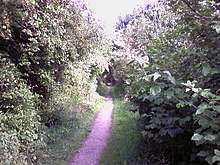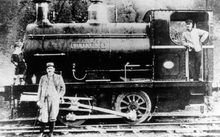Birley Collieries
The Birley Collieries were a group of coal mines set in the Shire Brook Valley in south east Sheffield, South Yorkshire, England. They were connected to the railway system by a branch line from the Manchester, Sheffield and Lincolnshire Railway at Woodhouse East Junction, about 800 yards east of Woodhouse station.
.jpg)
From 1877 to his death in 1926, William Dunn Gainsford was owner of the Birley Collieries, with his cousin Alfred John Gainsford serving as Managing Director.[1]
The collieries
The Birley collieries were owned by the Sheffield Coal Company who also owned nearby Brookhouse and North Staveley collieries. These collieries stood either side of the M.S.& L.R. line less than a mile to the east of Woodhouse East Junction.
In 1866 the Sheffield Coal Company, which had been founded in 1805, signed an agreement with the Earl Manvers to work below his lands in the Frecheville, Woodhouse and Hackenthorpe area, just outside the then Sheffield boundary. Over the following ten years they sunk and developed Birley West Colliery on a site in the Shirebrook Valley between Woodhouse and Hackenthorpe.
A further 10-year plan followed in which more land was acquired and a new shaft sunk, however, it was not until spring 1887 that work commenced on this new sinking. The following year the part completed colliery gained the name Birley East Colliery. Although a small amount of coal was being cut from the new colliery, brought to the surface at Birley West, it was not until 1890 when a new winding engine was installed that it fully came on stream. Later expansion came with mining rights being obtained from the Duke of Norfolk to mine below Handsworth Common.
Accidents
In 1876 six miners were killed in an explosion at the Birley Plantain Colliery.
On 13 March 1886 Benjamin Marriott (55) was accidentally killed by fall of Bind from the roof of Birley Vale West Pit
In 1898 a 16-year-old was crushed to death at Birley East Colliery by a full tub of coal coming of the rails. The boy had been working between 11 and 12 hours at the time of his death. Mr A. H. Stokes who was chief inspector of mines for the Midlands District criticised the use of boys doing overtime in his report.
In 1904 there was a fire in the engine house at Birley East Colliery which spread to the pit head. There were some 600 or 700 men and boys below and it took 2 hours to safely evacuate them all, using a neighbouring shaft. According to a report in the Tamworth Herald the pit head working were almost entirely destroyed.
On 23 February 1924 there was an explosion at Birley East Colliery where 4 people lost their lives and four others were injured.
On 13 December 1934 three miners, Harold Reaney (27), Ernest Redfearn (27) and Arthur Pearson (33) lost their lives at Birley East Colliery when a wet roof collapsed, causing 80 tons of coal to fall on the miners.
On 18 December 1936 Thomas William Linley (31) lost his life at Birley East Colliery.
On 23 October 1943, the final day of coal production before Birley East officially closed, John Prest died when shock waves caused an upper layer of coal to fall and trap him.
The end - not quite but nearly
Birley West drew its last coal in 1908 and production then concentrated on the East pit.
The last coal was drawn at Birley East on 15 October 1943 but the life of the pit was not quite at an end. In December 1943, Ernest Bevin, the Minister of Labour announced to the House of Commons that a ballot was to be held, from time to time, in which those men whose National Service Registration Certificates ended with the chosen number would be transferred to the mines. This gave rise to the term Bevin Boy. Many colliers had the new trainees alongside the production unit but at Birley they were able to use the recently closed facilities. Accommodation was provided in Nissen huts on Beighton Road, the first occupants arriving in early 1944.
Following the end of the Second World War and the demobilisation of the Bevin Boys, new trainees came, this time men from allied countries in Europe wanting to make their home in England, particularly a large contingent from Poland. Even after the last trainee moved on the end was not quite in sight - a new borehole topped with a pumping house was constructed on the site to help solve the water table problems at Brookhouse. This operated until the closure of Brookhouse Colliery in 1986 when it was finally switched off – the end for Birley had arrived.
The Birley Branch

In 1851 the Manchester, Sheffield and Lincolnshire Railway proposed to construct a series of short branch lines with the objective of increasing the railway's coal carrying. Parliamentary permission for these lines was granted under the M.S.& L.R. (Coal Branches) Act, 1852, but only one of the lines was built, that from Woodhouse East Junction to Birley (West) Colliery.
The Birley Coal Branch was 2.75 miles in length and came into use in June 1855, having been built by Thomas Waring and Company for the sum of £9,989.00. The line was single track and operated under the "one engine in steam" principle. The line was worked by the M.S.& L.R. (later Great Central Railway and London & North Eastern Railway) until 1934 when the colliery company took over operations. It was at this time that the colliery changed from a production unit to a training centre.
The Birley "Paddy Mail" accident, 1920
This accident took place on the section between Woodhouse and Birley West colliery. The "Paddy Mail" was 'topped and tailed' by colliery locomotives, Birley No.3 at the front and Orient at the rear. The driver on the front locomotive, Mr. A. Brammer, should have been in possession of the single line staff for the section, but he did not have it and the train was involved in a head-on accident with a light locomotive coming in the opposite direction. The two coaches were so badly damaged that they were replaced with a rake, bought second-hand, from the Great Northern Railway.
"Didn't we have a lovely day....."
The Paddy Mails were not the only passenger trains to use the branch. On an annual basis, from the mid-1890s to the outbreak of the First World War, the branch was used by the "Pitmen's Family Outing" – a trip, on which the workers voted for the destination from a selection of seaside resorts. The workers contributed 2d (less than 1p) per week to the 'trip fund'. The trains were run on Saturdays and started as early as 3.00 a.m. from the colliery yard, passengers boarding by ladder into coaches which could only be described as 'basic' - compartment stock with no toilets. The return train, depending on destination, could arrive back well into the early hours of the Sunday morning.
On 15 June 1907, three trains were run, in the working timetable, No.15 from Beighton at 5.00 a.m., No.14 and No.16 from Birley Colliery yard at 4.35 a.m. and 5.10 a.m. to Bridlington and Scarborough. All trains also called at Woodhouse. The trains arrived back just after midnight.
In total these trains were shown as carrying 50 committee members, 2,500 adults and 350 children.
In 1913, the excursion ran to Blackpool with a departure time from the colliery yard around 3.00 a.m. and an arrival back at 5.00 a.m. on the Sunday.
Locomotives
All the locomotives, except those shown, passed to the National Coal Board on nationalisation. The locomotives could be found working at either Birley or Brookhouse collieries as required, although some were allocated specific workings.

| No./Name | Wheel Arr. | Cyls. | Makers | Wks No. | Date Blt. | Notes |
|---|---|---|---|---|---|---|
| Belsize | 0-6-0ST | OC | BP | 1829 | 1878 | Withdrawn c.1928 |
| Birley No.1 | 0-4-0ST | OC | MW | 787 | 1881 | Sold to J. Aird & Co. |
| Birley No.2 | 0-4-0ST | OC | MW | Scrapped c.1911 | ||
| Orient | 0-6-0ST | IC | HC | 365 | 1890 | To Brookhouse 1951 |
| Birley No.3 | 0-4-0ST | OC | P | 972 | 1903 | Scrapped c.1940 |
| Birley No.4 | 0-4-0ST | OC | P | 1073 | 1907 | Scrapped 1933 |
| Birley No.5 | 0-4-0ST | OC | P | 1454 | 1917 | Transferred to Maltby |
| Birley No.6 | 0-4-0ST | OC | P | 1653 | 1927 | Withdrawn & cut up 12.67 - C.F. Booth, Rotherham. |
| WDG | 0-6-0ST | IC | P | 1634 | 1927 | William Dun Gainsford. Scrapped 2.67 |
| TRG | 0-6-0ST | IC | P | 1765 | 1929 | Thomas Robert Gainsford |
| Victory | 0-4-0ST | OC | AB | 1654 | 1920 | ex-Thos W Ward |
Abbreviations: Cylinders:
- IC:Inside Frames
- OC:Outside Frames.
Builders:
- AB:Andrew Barclay & Sons Co.
- HC:Hudswell Clarke & Co
- MW:Manning Wardle & Co.
- P :Peckett & Sons, Bristol
References
- "East of Sheffield", by Roger Milnes, Forward – The Journal of the Great Central Railway Society, No.16, March 1978. ISSN 0141-4488.
- Great Central Railway – original working timetables.
- "The Birley Vale Colliery Explosion". Sheffield Daily Telegraph, 28 June 1876
- "Fire at a Yorkshire Colliery". Tamworth Herald, 30 January 1904.
- "Report On the Causes of and Circumstances attending the Explosion which occurred in the East Pit of the Birley Colliery, Beighton, Yorkshire, on the 23rd February, 1924" by Henry Walker, C.B.E., H.M. Chief Inspector of Mines.
- "Three Miners Killed Fall Of Roof In Sheffield Pit". The Times, Saturday, 15 December 1934; pg. 4; issue 46938; col C
Further reading and listening
- Alan Rowles, Winding Up – the History of Birley East Colliery. Published by the author with assistance from Rotherham Metropolitan Borough Libraries. 1992. ISBN 0903666-61-8
- The Victorians – Cyril and Walter Hare. BBC Radio Sheffield / South Yorkshire Sound Archive.